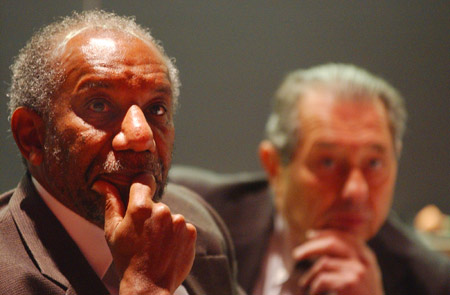Mind, memory, and the ‘Mozart effect’

They said the inaugural symposium on brain science would change our brains if we stayed awake, and they were right.
Learning and memory are nothing more – or less – than alterations in the connections among the billions of nerve cells that make up our brains, noted Carla Shatz, Pusey Professor of Neurobiology at Harvard Medical School. Things heard and seen at the installation of President Lawrence H. Summers changed some of those connections, reinforced others. Some things will make short-term memories, others long-term memories.
Such a view of the brain is relatively recent, noted Jerome Kagan, Starch Research Professor of Psychology and moderator of the symposium, titled “Brain Science and the Science of Learning.” Fifty years ago, he said, “Children who had difficulty learning were labeled poorly prepared, anxious, or rebellious. We assumed there was nothing wrong with their brains.”
Today, Kagan continued, we use powerful brain scanners that allow us to see actual changes in brain activity as a child learns or doesn’t learn. The machines allow neuroscientists to actually see what happens when different parts are damaged or underdeveloped.
Most of the critical connections are made in early childhood, Shatz pointed out. But they go on all through life. “The brain continually remodels itself,” she said. New connections are made and old ones can be lost if they’re not used.”
Shatz summed up 50 years of brain research by warning the audience to “use it or lose it.”
Brain damage and imaging devices also locate specific areas of the brain where memories form, noted Daniel Schacter, a professor of psychology and author of “The Seven Sins of Memory.” During the past 50 years, we’ve learned that memory is not stored in one place but distributed through the brain, he said.
The hippocampus, a small curved organ lying deep in the brain, is critical to memory, but it doesn’t recall the whole story. Schacter described a patient who had his hippocampus removed to treat intractable epilepsy. The surgery, which is no longer done, left him without the ability to recall events in the recent past. (The recent movie “Memento” centers on a character with such an affliction who tattoos on his body those facts he wants to remember.)
Schacter discussed a brain-scanning technique that predicts what will be remembered, or forgotten, by measuring activity in the hippocampal area. Words heard when that area shows the greatest activity will be remembered; those heard when it appears inactive are most likely to be forgotten.
Kagan applauded such revealing discoveries but wondered aloud how they could be used in the classroom.
Howard Gardner, Hobbs Professor of Cognition and Education at the Graduate School of Education, had one answer. Anomalies of the brain may allow us to pinpoint the causes of various learning problems. For example, he asked, “Does a reading difficulty occur because a child has a problem in a region that processes sight or in one that controls hearing?”
Gardner also proposed investigating the controversial Mozart effect by long-term studies of brain activity. At least one short-term study concludes that children exposed to Mozart sonatas in the womb do better on later tests of their spatial skills. “That effect raises the question of whether you can train one area of the brain to produce long-lasting improvements in another area,” he noted. “If children are trained in music, will it improve their skills in geometry or architecture? Conversely, if children learn to run mazes, will that lead to increased appreciation of music? It’s very controversial, but if it proves out, teachers could make use of it.”
The public has yet to be convinced that all thought and emotions come from changes in the brain, said Steven Pinker, de Florez Professor of Psychology at the Massachusetts Institute of Technology and author of “How the Mind Works.” “A general belief exists that there are two kinds of intelligence, one of which is beyond the brain,” he said.
“The belief in a separate soul or ‘ghost in the machine,’ has a significant impact on public policy. Take the decision on stem cell research. One of the most promising developments in the 21st century is being debated in medieval terms. Much of the public does not want to believe that human will and values evolved in a piece of meat. When all people finally react to what neuroscientists already know, that will have a profound positive effect on the future of science and society.”
The brain dictates how we learn, but learning does not occur at the same rate for every child, and schools should take that into account, noted Felton Earls, professor of social medicine at Harvard Medical School and of human behavior and development at the Harvard School of Public Health. He used the example of delaying gratification.
“The capacity to wait arises between the ages of 2 and 4, and studies show that it affects concentration and is predictive of scores on college entrance exams,” Earls said. “Girls acquire it faster than boys, and boys who are particularly bad at acquiring it put themselves on the road to attention deficit disorder.”
Such knowledge can be used for teaching and treating young children. For example, Earls pointed out, “Boys and girls could be taught separately until the age of 7 or 8, when the ability to wait evens out. In the future, the findings of neuroscience will be used to design better learning environments the way we now use such findings to design better medicines.”




